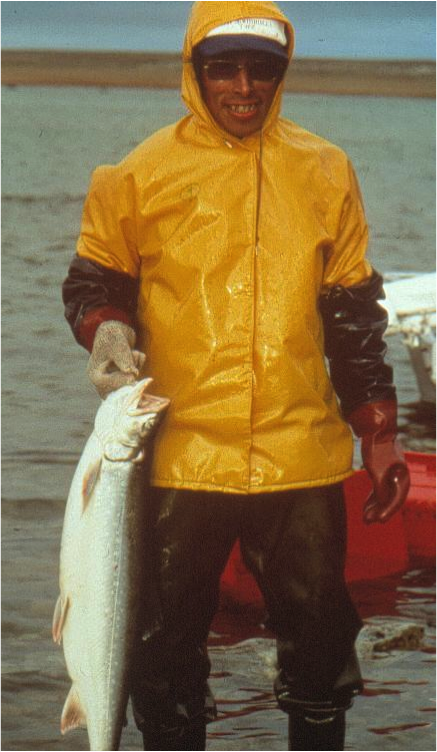 Otoliths
Otoliths
Conservation and management of fish stocks hinges
on an accurate assessment of the life histories of fish, environmental factors
affecting their behaviour and growth, and population stock structure. Scanning
proton microprobe can be used to establish the correspondence between Sr
variation and optically resolved annuli in arctic charr otoliths. Anadromous
and non- migratory fish can be unambiguously distinguished based on Sr
distribution in otoliths. Otoliths from non-migratory fish have flat Sr
profiles. In otoliths from migratory charr, Sr levels are low in the primordium
and the first several annuli; the transition to a marine environment is marked
by a sudden increase in Sr and a distinctive oscillatory zonation in Sr
concentrations. Quantitative analysis of Sr can be used to distinguish the
geographic origin of the fish.

The image on the left shows a 2-D Sr X-ray map of an otolith from a spawning
char. Low-Sr annuli, clearly seen on both lobes of the otolith, indicate a
period of freshwater residence that may be related to spawning activity. The
image below shows Zn and Sr scans superimposed on a reflected light optical
image of an otolith. Zn is an
important biologically mediated element (particularly during gamete
production), it is also a significant component of many mineral deposits. Our most recent work has shown that Zn also
shows a systematic pattern of oscillations.
More importantly, this oscillatory Zn content can be linked to the Sr
variation and known life-history events in tagged fish and used as a proxy for
size and growth rate, nutrient availability and environmental conditions and
maybe also reproductive viability.


The incorporation of trace
elements in otoliths crosses the interface between the inorganic and organic
environment. The trace-element signature
found in the otoliths from fish in Eden
Lake is very similar to
that found in carbonates in the surrounding rocks arguing strongly that these
elements were originally derived from the surrounding rocks. Carbonate minerals in rocks commonly
luminesce and preserve a chemical record of their growth. In this case the same appears to be true for
otoliths. To correctly interpret the
zoning signals we will require knowledge of the environment surrounding the
fish habitat (including the rock, mineral and water chemistry), the fish’s
metabolism and behaviour as well as information on nutrient type and
availability
Primary and
strategic mineral production remains a key part of the Canadian economy, it
underpins many small communities, particularly in northern and rural Canada. In such settings the mineral industry must
coexist with other resources and resource based economies (e.g., commercial,
sport and aboriginal subsistence fisheries).
Aqueous environments represent regions of significant element mobility
and dispersal so fish at some point are likely to come in contact with acid
mine effluents. The aragonitic makeup of the otolith, and the fact that it
preserves an annular growth record, means that it can sensitively record such
chemical variation in the environment.
In this image the absolute values of Mn, Zn and Sr are much higher than
have been encountered in our other micro-PIXE analyses of otoliths from
freshwater fish. The exceptionally high
level of Zn recorded in a single lake whitefish otolith is the most unusual; it
is amongst the highest Zn concentrations that we have recorded in any
otolith. The most reasonable explanation
for the high Zn content is that at an early stage in its life this fish came
into contact with RATS effluence from the Sherridon tailings. Oscillating Zn might suggest that it
migrated to and from where it may have been spawned. The bulk of its adult life was probably spent
in the main lake. New work done using LA-ICP-MS indicates we can determine many more elements even
at very low (parts per billion) concentrations.
References:
Friedrich, L. A. and Halden, N.M. (2010) Determining Exposure History of Northern Pike and Walleye to Tailings Effluence using Trace Metal Uptake in Otoliths. Environmental Science and Technology (in press).
Halden, N. M. And
Friedrich,
L.A.
(2008) Trace element distributions in fish otoliths: natural markers of life
histories, environmental conditions and exposure to tailings effluence.
Mineralogical Magazine 23 (2), 591-603.
Friedrich, L. A. and Halden, N.M.
(2008) Alkali element uptake in otoliths: a link between the environment and
otolith microchemistry. Environmental
Science and Technology 42, 10,
3524-3518.
Riva-Rossi,
C., Pascual, M.A., Babaluk, J.A. and Halden, N.M. (2007) Intra-populational
Variation in Anadromy and Reproductive Lifespan in Santa Cruz River Rainbow
Trout Journal of Fish Biology 70,
1780-1797.
Palace V.P., Halden, N.M., Yang, P.,Evans,
R.E. and Sterling,
G. (2007) Determining life histories of rainbow trout using laser ablation
inductively coupled plasma mass spectrometry
(LA-ICP-MS) analysis of selenium in otoliths. Environmental Science and
Technology. 41, 3679-3683.
Halden, N. M., Mathers, K, , Babaluk, J. A. and Mejia, S.R. (2004) Cathodoluminescence
Microscopy: a useful tool for assessing incremental chemical variation in
otoliths. Environmental
Biology of Fishes. 71, 53-61.
Saquet, M., Halden, N.M.,
Babaluk, J.A., Campbell, J.L. & Nejedly, Z. (2002) Micro-PIXE analysis of
trace element variation in otoliths from fish collected near acid mine
tailings: potential for monitoring contaminant dispersal. Nuclear Instruments
and Methods B 189, 196-201
Babaluk, J.A.,
Campbell, J.L. Evans, C.L., Halden, N.M., Mejia, S.R., Nejedly Z., Reist, J.D.
and Teesdale, W.T. (2002) Micro- PIXE
analysis of strontium in Arctic char otoliths from Quttinirpaaq National Park,
Nunavut, Canada. Nuclear Instruments and Methods B 189, 190-195.
Campbell, J.L.,
Babaluk, J A., Cooper, Grime, W., Halden, N.M., Nejedly Z., Rajta, I. and Reist, J.D. (2002)
Strontium distribution in young-of-the-year Dolly Varden otoliths: potential
for stock discrimination Nuclear Instruments and Methods B 189, 185-189.
Halden, N.M.,
Mejia, S.R., Babaluk J.A., Reist J.D., Kristofferson, A.H., Campbell, J.L.and Teesdale,
W.T. (2000) Oscillatory zinc distribution in Arctic char (Salvelinus alpinus)
otoliths: the result of biology or environment?
Fisheries Research 46, 289-298.
Meldrum, A. and Halden, N.M.
(1999) Fine-scale oscillatory banding in otoliths from arctic charr (salvelinus alpinus) and Pike (Esox Lucius) Mat. Res. Soc. Symp. Proc.
Vol. 489.167-172.
Babaluk, J.A., Halden,
N.M., Reist, J.D., Kristofferson, A.H., Campbell, J.L., Teesdale, W.J., (1997) Evidence for
non-anadromous behaviour of Arctic charr (Salvelinus
alpinus) from Lake Hazen, Ellesmere
Island, Northwest Territories, Canada, based on otolith strontium
distribution. Arctic. 50, 224-223.
Halden, N.M.,
Babaluk, J.A., Kristofferson, A.H., Campbell,
J.L., Teesdale, W.J., Maxwell, J.A. and Reist, J.D. (1996). Micro-PIXE studies
of Sr zoning in Arctic charr
otoliths: migratory behaviour and stock discrimination. Nuclear Instruments and
Methods in Physics Research B 109/110 592-597.
Halden, N.M.,
Babaluk, J.A., Campbell,
J.L., Teesdale, W.J. (1995) Scanning proton microprobe analysis of strontium in
Arctic char : implications for the interpretation of anadromy. Environmental Biology of Fishes. 43, 333-339.
Babaluck,
J.A., Halden, N.M.,
Reist, J.D., Kristofferson, A.H., Campbell, J.L., Teesdale, W.J.(1995) To sea
or not to sea - evidence for non-anadromous behaviour of Arctic char
{Salvelinus alpinus} from Lake Hazen, Ellesmere
Island, Northwest Territories.
75th Annual meeting of the American Society of Ichthyologists and
Herpetologists. Edmonton, Canada.
Conferences:
Halden, N. M., Friedrich, L. A., Babaluk, J. A.
& Wastle R.J. (2005) Trace
Element Distributions in Lake Trout Otoliths: Indicators of Life Histories and
Environmental Conditions? 2nd Annual North American Trout Symposium Yellowknife August 18-20.
Friedrich, L.A. and Halden, N.M. (2005)
Alkali element uptake in otoliths: a link between geography and otolith
microchemistry Society of Environmental Toxicology
and Chemistry: Baltimore
November 17 -19.
Halden, N.M., Campbell,
J.L. and Babaluk J.A. 2004 Scanning proton microprobe analysis of lake sturgeon
pectoral fin rays: micro-chemical variation and life history information. 10th
International Conference on Particle Induced X-ray Emission and its Analytical
Application 4-8 June, 2004, Congress Centre Bernardin, Portoro, Slovenia
Back to Norman Halden's Home Page
 Otoliths
Otoliths


